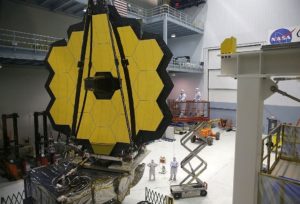James Webb Telescope Heads to Deep Space
The James Webb Telescope will help scientists make new discoveries about the universe and its origin.
By: Keelin Ferris | January 21, 2022 | 534 Words

(Photo by Paul Aiken/Digital First Media/Boulder Daily Camera via Getty Images)
The James Webb Space Telescope is the largest and most powerful space telescope ever built. It was launched into space on December 25 from French Guiana, South America, but it took a while to fully deploy. It was created in a joint mission by NASA, the European Space Agency, and the Canadian Space Agency, and it took years to prepare.
In a unique feat of engineering, the telescope eventually unfolded a sun shield. This tennis-court-sized membrane has five layers about the width of a human hair, and it will protect the sensitive instruments from solar damage.
After deploying the shield, the telescope is now going to deep space. As it orbits about one million miles from Earth, it will help scientists grow their knowledge of the universe and its origin. The “Webb” is a successor to the Hubble Space Telescope. The Hubble is just 400 miles away, but its discoveries laid the groundwork for what the Webb hopes to accomplish.
What Will It Do?

(Photo by Alex Wong/Getty Images)
Equipped with 18 hexagonal mirror segments to take pictures, the James Webb Telescope will take photos of the universe and send them back down to scientists on Earth to study. However, it will take a while for the images to look right. Webb’s operation experts believe it will take about 120 days for the 18 mirrors to align and gradually take a perfect, light-absorbing photo.
Once all 18 mirrors are aligned, the next task is determining what they will look at. NASA won’t disclose what it plans to aim the telescope at first, but the agency did share that it will look at the Large Magellanic Cloud to see how the telescope is working because it has “nice and uniform brightness.” The Large Magellanic Cloud is a satellite dwarf galaxy in the Milky Way, one of the closest galaxies to Earth.
Astronomers don’t know whether life forms exist on other planets. They have, however, found thousands of exoplanets. This telescope will examine the atmospheres of exoplanets and help us learn whether they contain different life forms or are habitable.
What’s So Special About it?
 The Webb can see the universe in light invisible to our human eyes. This kind of light is infrared radiation. We cannot see it, but we can feel it as heat. The telescope will use its infrared camera to see through dust in the universe. Planets and stars form inside dust clouds, so with the James Webb, our scientists will be able to see them developing. The Hubble telescope only used ultraviolet and optical light wavelengths, but the James Webb will see beyond what the Hubble observed.
The Webb can see the universe in light invisible to our human eyes. This kind of light is infrared radiation. We cannot see it, but we can feel it as heat. The telescope will use its infrared camera to see through dust in the universe. Planets and stars form inside dust clouds, so with the James Webb, our scientists will be able to see them developing. The Hubble telescope only used ultraviolet and optical light wavelengths, but the James Webb will see beyond what the Hubble observed.
It will be able to see galaxies that a very far away and very old – maybe even the first galaxies. That’s because the light of these old galaxies has changed from the visible light that humans can see to the infrared wavelength.
In an exciting statement, NASA Administrator Bill Nelson called the telescope a “time machine.” He said, “It’s going to take us back to the very beginnings of the universe. We are going to discover incredible things that we never imagined.”
















